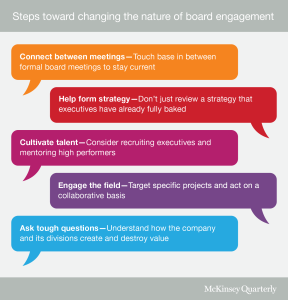Five tips for directors and CEOs striving to make the most of their limited time.
“Ask me for anything,” Napoleon Bonaparte once remarked, “but time.” Board members today also don’t have that luxury. Directors remain under pressure from activist investors and other constituents, regulation is becoming more demanding, and businesses are growing more complex. McKinsey research suggests that the most effective directors are meeting these challenges by spending twice as many days a year on board activities as other directors do.
As directors and management teams adapt, they’re bumping into limits—both on the amount of time directors can be asked to spend before the role is no longer attractive and on the scope of the activities they can undertake before creating organizational noise or concerns among top executives about micromanagement. We recently discussed some of these tensions with board members and executives at Prium, a New York–based forum for CEOs.3 The ideas that emerged, while far from definitive, provide constructive lessons for boardrooms. If there’s one overriding theme, it’s that boosting effectiveness isn’t just about spending more time; it’s also about changing the nature of the engagement between directors and the executive teams they work with.
Boosting the effectiveness of boards isn’t just about spending more time.
Engaging between meetings.
Engaging with strategy as it’s forming.
Engaging on talent.
Engaging the field.
Engaging on the tough questions.
More: mckinsey.com; hbr.org.
Authors: Bill Huyett is a director in McKinsey’s Boston office, and Rodney Zemmel is a director in the New York office.





